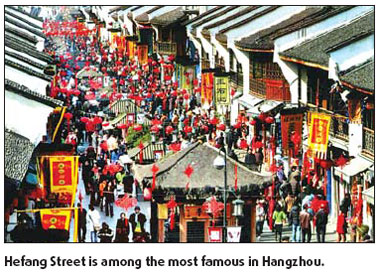
China's Spring Festival (Lunar New Year), the most important holiday for the nation, is a traditional Chinese festival that has existed for thousands of years. Today a series of customs are spreading far and wide.
In order to continue the traditions of the Chinese culture and let visitors from home and abroad learn more and better understand the customs of the Spring Festival, Songcheng, Hangzhou, east China's Zhejiang province, will put on a series of activities in Songcheng scenic spot to help promote its image during the Festival.
2009 Songcheng Temple Fair is one important part of these activities. There are a number of highlights in this year's temple fair, which will be held in Songcheng scenic spot in Hangzhou from Jan 26 to Feb 9.
The temple fair, usually held outside temples, is a type of folk custom in China. In recent years, visiting the temple fair has become a way for people to appreciate the traditional arts and experience traditional lifestyles. It has become very popular with tourists during the winter.
During the Spring Festival, the Songcheng temple fair provides acrobatics, Wushu (the martial art), shadow show, and many other folk local dramatic performances. Tourists can also enjoy a range of local and traditional snacks.
There's a saying in Chinese "Min yi shi wei tian", which means food is foremost important for people. Both emperors of the past and governors today pay close attention to agriculture production. Thus some folk customs have links to agricultural history.
Among the 24 solar terms, the Beginning of Spring, the first term, represents that a vigorous spring begins. In ancient China and even today, on the early morning of the Beginning of Spring, people gather in front of the gate of the local government to watch the governor whipping the spring ox in a county. No matter what kind of ox, clay, reed, paper or real, an ox would usually be whipped three times. The whipping of the spring ox indicates the beginning of crop cultivation, which, in addition, is regarded as a way of praying for a good harvest based on the hardworking of the whipped oxen.
This custom dates back to the Zhou Dynasty (c. 11th century-256 BC). Records about the custom also can be found in the files of the Song Dynasty (AD 420-479). Moreover, relevant activities prevailed in the Ming and Qing dynasties (1368-1911). The latest record of the custom to welcome the beginning of spring - whipping the spring ox was in 1911, some one hundred years ago. Visitors can see a modern version of the old custom in the temple fair.
Other activities include ceremonies of offering sacrifices to ancestors and the gods, praying for seasonable weather for crop raising as well as the country flourishing and people living in peace, and praying for plentiful money and treasures like a river flowing into one's pocket.
Visitors will also be interested in other prayer events in the temple fair. Cai Shen literally translates as God of Wealth or Prosperity. People believe that Cai Shen can bring them wealth if they pray or hold a memorial ceremony during the Festival.
Yue Lao, go-between or matchmaker in English, is the deity living on the moon in charge of marriages. According to the Chinese legend, Yue Lao ties an invisible red string around the ankles of men and women who are destined to be soul mates and will one day marry each other. Therefore, the young people can come to pray for a good company for their life in the temple fair.
Places of worship for Buddhism are also available for Buddhists praying for Buddha's uncountable blessing for the coming year in the temple fair.
Old workshops undergo a facelift to welcome visitors with new decorations. Some new workshops will also be open to the visitors. The workshops in the temple fair include a brewery house, bean curd mill, blacksmith's shop, wax printing shop, and other shops engaged in root carving, stone inscription, paper-cut, facial makeup in operas and others. Craftsman from those workshops will bring people on-site performances making different kinds of crafts.
Wasi Goulan, a place for amusement for common people, came into use in the Song Dynasty (AD 420-479). With the most dangerous, interesting and infrequent shows performed here, Wasi Goulan is a good place for recreation and amusement as well as leisure and a good sport for a vacation in the Song Dynasty. The temple fair will blaze a piece of land for visitors to enjoy some local dramas and performances like Muppet, shadow puppet show, Drum Song of Peking, magic tricks, and some other acrobatics.
Sports events are also highlights of the temple fair. In the Song Dynasty, emperors, empress and their children were all fond of sports. One popular sport, Cuju, an ancient sport played in ancient China, had some resemblance to football (soccer) today. The Northern Song Dynasty saw an unprecedented development of the Cuju game. Visitors can enjoy the sports generated from the past dynasties such as shooting arrows, throwing balls made of colored silk, target practicing, throwing earthbags and spinning top.
Some other traditional performances and custom will be on display in the places like Hefang Street, where people wearing historic costumes as well as dancing and singing in local styles, attracting people's eyes in the temple fair too.
(China Daily January 22, 2009)